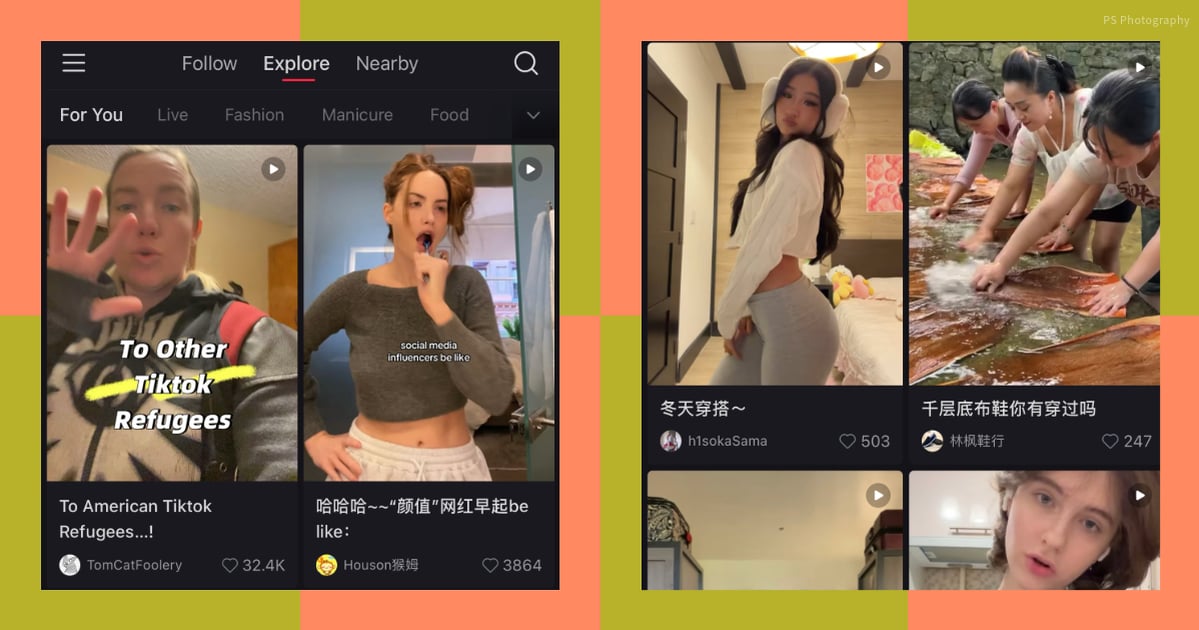As it stands, TikTok is on track to being banned in the United States on Jan. 19. (That is, if ByteDance, the Chinese tech company that owns the app, doesn’t sell its US operations by then – TBD.) If you’re starting the grieving process thinking your TikTok renegade days are over, say hello to the Internet’s newest obsession: RedNote.
Translated from “Xiaohongshu” in Mandarin, RedNote is a Chinese-based app where people can share videos and general lifestyle content. Similarly to TikTok, it’s a platform where you can “uncover lifestyle trends and a range of diverse interests and hobbies that are popular among young people,” according to its description in the app store.
Whether you are looking for beauty trends like the “broccoli haircut” or fitness tips à la the 12-3-30 workout, RedNote is quickly becoming the go-to source for many displaced TikTok users in the US. But how does it compare to the app that got everyone through the pandemic? According to some reviewers, it’s better.
One person wrote that the app feels like “going back in time to the 2019/2020 free-spirited and fun TikTok we used to have.” Another reviewer compared it to Pinterest, stating they like it even more than the visual-content sharing platform.
So what is RedNote exactly, and how can you change RedNote to English? All the information you need right this way.
What Is RedNote?
RedNote is a free Chinese-based app that launched in 2013. “RedNote is a lifestyle platform that inspires people to discover and connect with a range of diverse lifestyles, where over 300 million users every month share their life experiences,” the app description reads.
Referred to as the perfect mix between Pinterest, Instagram, and TikTok, RedNote is a great option for people looking to fill the post-TikTok-ban void. However, users are noticing that there are a few differences in the app. For one, the language is set to Mandarin, so while you can change your profile settings to English, the majority of the videos you see are likely to be in Mandarin.
Another thing people are noting: Because RedNote is a Chinese-based app, when you agree to the app terms, you agree to follow Chinese law. This means there are stricter rules on content, so one TikTok user recommends “avoid posting anything political, offensive, or anything that violates privacy or intellectual property rights.”
What Does RedNote Look Like?
RedNote has a very similar interface to TikTok, so if you’re already familiar with TikTok, it will be easy to adapt to RedNote. Just like TikTok, at the top of RedNote, you have a “For You” page and a “Live” option. You also have channels you can add that include categories like fashion, manicure, food, handmade, hairstyle, painting, celebrity, home decoration, and more.
At the bottom of the app, there’s a “Trending” space, where you can see what videos are going viral, a “Messages” area, where you can share videos with friends and followers, and a “Me” section, where you can access your profile.
How to Change RedNote to English
If you don’t know Mandarin, you will likely have a hard time navigating the app. But if you download the app from the US app store, it will automatically change your settings to English. If you use your phone number for your login, the app will also automate your settings to English. (You don’t have to create a profile in order to view videos, however.)
If your app does not change to English right away, you still have some options. Simply take a screenshot of the interface and drop the screenshot into Google Translate (or any other translator that allows you to upload photos). Once the text is translated, you can then use that to find “Settings” within the app and make your default language English. Just note that this will only change the platform settings to English – most of the videos and captions you come across on your “For You” page will likely be in Mandarin.
Interested in checking out the app yourself? Download it here.
Taylor Andrews (she/her) is the balance editor at PS, specializing in topics relating to sex, relationships, dating, sexual health, mental health, travel, and more. With seven years of editorial experience, Taylor has a strong background in content creation and storytelling. Prior to joining PS in 2021, she worked at Cosmopolitan.




